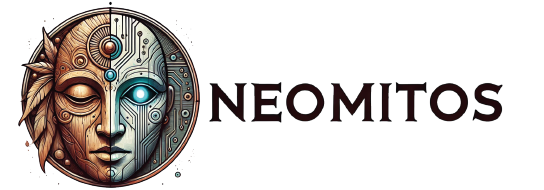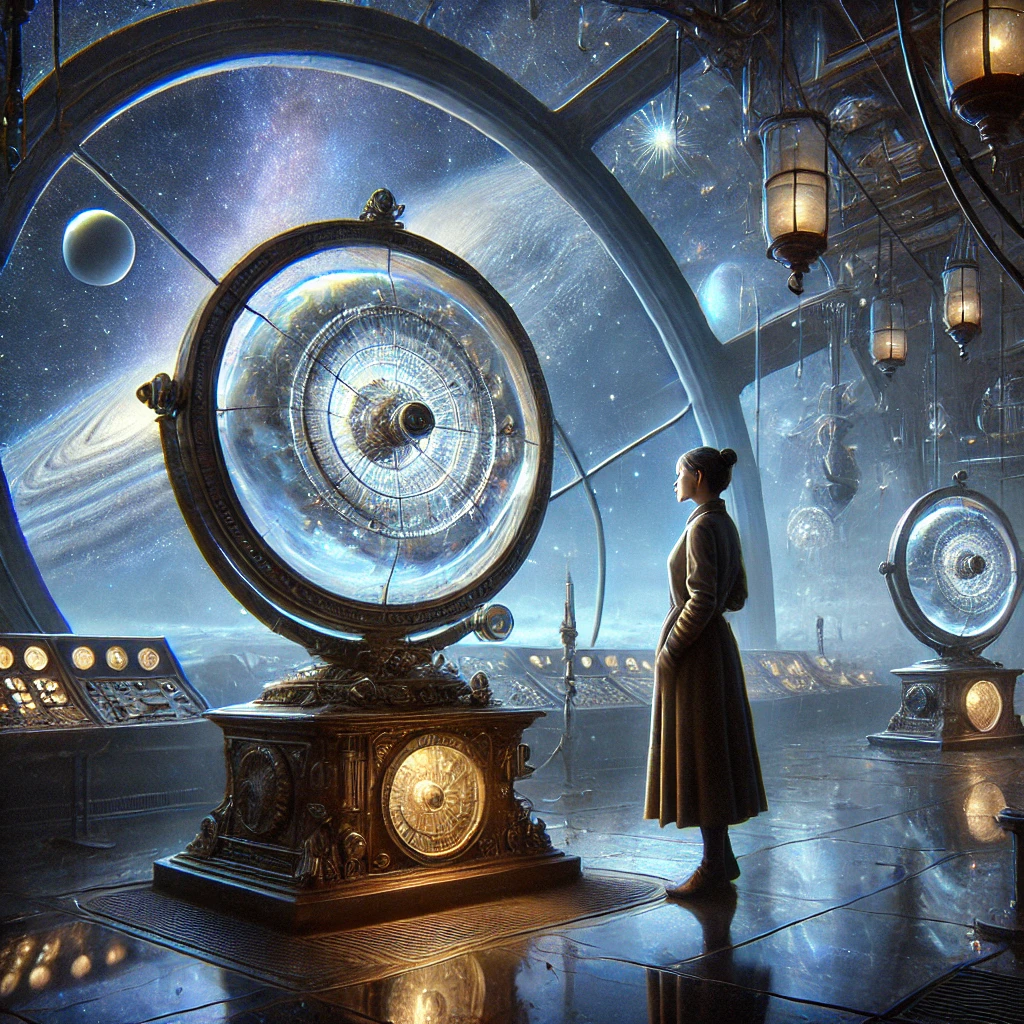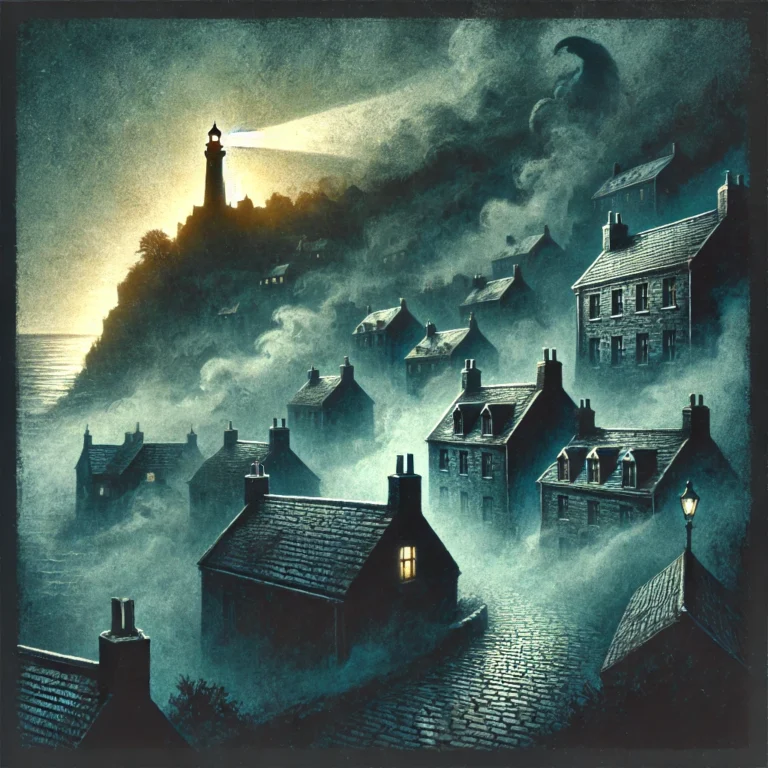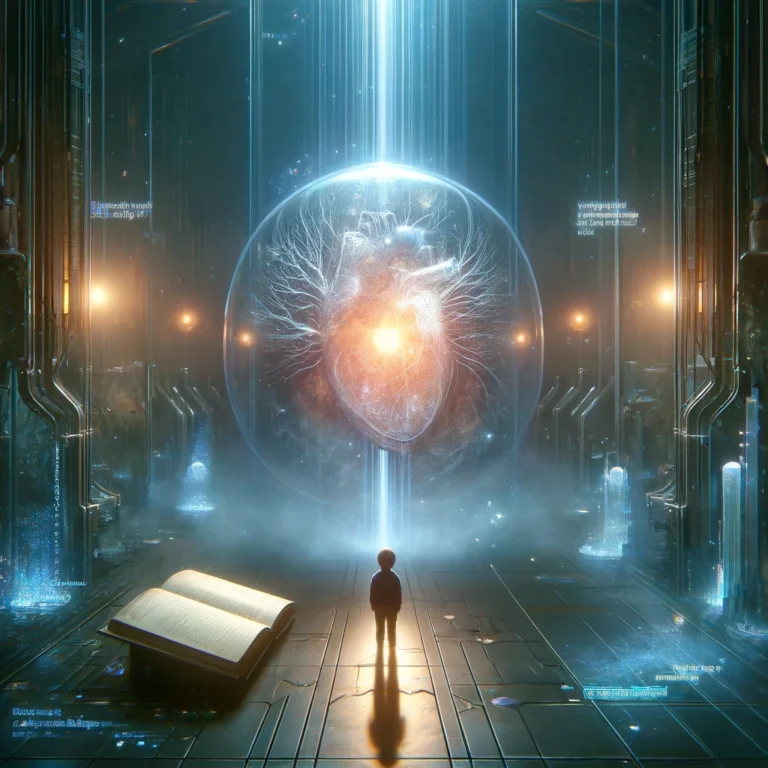The Cartographers of Eternity
The Silent Echoes of Time
The hum was almost imperceptible, a high-frequency vibration that filtered through the walls of Chronos Station, a constant reminder of the delicate dance of temporal dilation fields that kept the present safe from the intrusions of the past and the premonitions of the future. For Anya Volkov, however, this hum was the soundtrack of her existence, a familiar melody that accompanied her as she delved into the invisible strata of time.
In the main observation room, the light was dim, designed to minimize interference with the sensitive instruments. Anya stood before her temporal theodolite, an intricate apparatus of crystalline lenses, induction coils, and delicate calibrators. Her fingers, slender and agile, precisely adjusted the dials, while her eyes were glued to the eyepiece.

Through the lens, the universe did not present itself as a canvas of bright stars and spiraling galaxies. Instead, Anya contemplated a subtle topography, a landscape of undulations and folds in the fabric of time itself. These were the “temporal scars,” the silent echoes of events that had left their imprint on the space-time continuum.
Today, her attention was focused on a newly detected anomaly, cataloged as TX-47 Omicron. It wasn’t one of the large disturbances, like the residual echo of a massive star’s explosion or the blurry premonition of two black holes colliding. TX-47 Omicron was more subtle, a small vibration, almost like a speck of dust in a beam of light, but its persistence and unusual signature had piqued Anya’s curiosity.
According to preliminary data, the anomaly seemed to originate from a specific point in the past, approximately three millennia ago on Earth. This dating, in itself, wasn’t particularly significant. The universe was full of echoes of ancient events. What intrigued Anya was the quality of the signal, a strange resonance that didn’t correspond to any known phenomenon.
“Any new readings, Anya?” Professor Elias Thorne’s deep voice resonated softly from the observation room door. The professor, with his snow-white hair and piercing eyes, approached slowly, leaning on his carved wooden cane.
“It’s evolving, Professor,” Anya replied, without taking her eyes off the eyepiece. “The wave amplitude is increasing slightly, but the frequency remains anomalous. There’s no discernible energy signature, just this… vibration.”
Thorne approached and observed the secondary monitor displaying a graphical representation of the anomaly. The lines trembled irregularly, without the predictable pattern of a gravitational wave or a quantum fluctuation.
“Interesting,” the professor murmured, frowning. “It vaguely resembles the resonances we detected near the remnants of the Crab Nebula, but much fainter and with a different spectral structure.”
“Exactly,” Anya nodded. “And the dating… coincides with the approximate time of the Silent Architects’ disappearance.”
The name floated in the air of the room, laden with mystery and speculation. The Silent Architects. A civilization that had reached a pinnacle of knowledge and technology, only to vanish from the cosmic record, leaving behind nothing but legends and these elusive scars in time.
Anya felt a deep fascination for them, an almost personal connection to their enigma. In her mind, the Silent Architects were not just a scientific mystery, but a mirror reflecting the possibilities and dangers of progress, a reminder of the fragility of existence even on cosmic scales.
“Do you think TX-47 Omicron could be related to them?” Thorne asked, his voice now tinged with cautious excitement.
“It’s a possibility we can’t rule out,” Anya replied. “The temporal location is suggestive. And this strange resonance… it could be an echo of something we don’t understand.”
Anya activated her theodolite’s temporal resonator. A small pulse of chronal energy emanated from the device, traveling into the past at the speed of causality. The room fell silent as they awaited the response.
In the viewer, the temporal topography briefly intensified, as if a stone had been thrown into a still pond. Then, a series of data began to flow onto the monitors, complex strings of numbers and graphs that Anya and the professor scrutinized.
“The probe has interacted with something,” Anya announced finally. “A structure… very faint. It’s not matter in the conventional sense. It seems more like an… imprint.”
“An imprint of what?” Thorne asked, leaning over Anya’s shoulder.
“I’m not sure,” she replied, her brow furrowed. “It’s as if the very fabric of time has retained a memory of something that no longer exists. The structure is… complex, almost organic.”
Anya manipulated the controls, adjusting the resonator’s parameters. She sent another probe, this time with a slightly different frequency. The response was similar, but with more detail. Slowly, an image began to form in the viewer, an abstract representation of the temporal imprint.
It wasn’t the clear image of the crystal city she had glimpsed in her previous research on the Silent Architects. This was different, more fundamental. It looked like an intricate pattern, a network of luminous filaments that intertwined in a complex geometric form, like a cosmic mandala.
“It’s beautiful,” Anya whispered, almost to herself. There was an inherent elegance in the structure, a sense of purpose and harmony that transcended mere chance.
“Do you recognize any pattern?” Thorne asked.
Anya shook her head. “I’ve never seen anything like it. It doesn’t correspond to any of the cataloged temporal signatures.”
At that moment, the door to the room opened and Jax, the chronal systems technician, entered with his usual nonchalant air. He held a tablet in his hand.
“Anya, Director Petrova wants to see you in her office,” Jax said. “Looks like there’s news about the project funding.”
Anya sighed. She knew that funding discussions were always delicate, especially when it came to research as esoteric as temporal cartography.
“I’ll be right there,” she replied. “Professor, could you continue monitoring TX-47 Omicron? I want to analyze this data further when I return.”
“Of course, Anya,” Thorne nodded. “I’ll keep an eye on this fascinating imprint. Who knows what secrets it might reveal.”
Anya left the observation room, leaving Professor Thorne engrossed in the study of the mysterious anomaly. As she walked through the silent corridors of Chronos Station, her mind kept returning to the image of the intricate luminous network she had glimpsed in the viewer. What was it? A vestige of the Silent Architects’ technology? A trace of their collective consciousness? Or something completely different, something that defied her current understanding of time and space?
Director Petrova’s office was functional and austere, with large windows offering a panoramic view of the vast expanse of space. Lena Petrova, a middle-aged woman with a sharp gaze and an air of efficiency, sat behind her desk, reviewing some documents.
“Anya, thank you for coming,” the director said, looking up. “We have news about the renewal of our funding from the Galactic Council.”
Anya waited in silence, with a mixture of hope and apprehension. Funding was essential for the operation of Chronos Station and the continuation of their research.
“The news is… mixed,” Petrova continued, setting the documents aside. “The Council has approved an extension of the funding for another two Earth cycles, but with some conditions.”
“Conditions?” Anya asked, feeling a slight apprehension.
“Yes,” the director replied. “They have expressed concern about the lack of tangible results in our research on the Silent Architects. They want to see significant progress within this timeframe, or they might reconsider their support.”
Anya felt a lurch in her stomach. She knew that the research on the Silent Architects was considered by many to be a fruitless pursuit, a scientific luxury that yielded no immediate practical benefits.
“I understand,” Anya said, trying to remain calm. “We will assure them that we are doing everything possible to advance our understanding.”
“I hope so, Anya,” Petrova said, with a serious tone. “This research is important, I know. But we also need to justify the investment being made in it. The Council is interested in results, in practical applications of our knowledge of time.”
The director paused, looking intently at Anya.
“There’s something else,” Petrova added. “We have received a collaboration request from the University of Xylos. They are interested in using our data on temporal anomalies for their own research.”
The University of Xylos was a prestigious institution, known for its more theoretical and mathematical approach to temporal physics. A collaboration could be beneficial, but Anya also felt a pang of unease.
“What kind of collaboration are they proposing?” she asked.
“They want access to our temporal scan records and our predictive models,” Petrova replied. “In return, they would offer us their own theoretical analyses and potential new perspectives on our observations.”
Anya pondered the proposal. Sharing their data could lead to new discoveries, but it also meant losing some control over their research.
“I’ll need to review the details of the proposal before giving an answer,” Anya said.
“Of course,” Petrova nodded. “I’ll send you the full report. Think carefully, Anya. This collaboration could be crucial for securing our long-term funding.”
Anya nodded, feeling overwhelmed by the pressure. The search for the Silent Architects had become even more urgent. She had two Earth cycles to find answers, to demonstrate the value of their work to the Galactic Council.
Back in the observation room, Anya found Professor Thorne still engrossed in the study of the TX-47 Omicron data.
“Any news?” Anya asked.
“I’ve been analyzing the structure of the imprint,” Thorne replied, pointing to the monitor. “I’ve found some similarities with certain fractal patterns observed in complex biological systems. It’s as if this temporal imprint has a kind of… code.”
“A code?” Anya approached the monitor, examining the intricate patterns of light.
“Yes,” Thorne said. “A language, perhaps. But not one we can understand with our current knowledge.”
Anya felt a surge of excitement. Could this be the key to the mystery of the Silent Architects? A message encoded in the very fabric of time?
“We need to analyze this further,” Anya said, with determination in her voice. “We need to find a way to decipher this code.”
“I agree,” Thorne nodded. “This could be the breakthrough we’ve been looking for.”
Anya and Professor Thorne leaned over the console, the screen displaying the intricate network of luminous filaments of the TX-47 Omicron imprint. The patterns seemed to dance and subtly change, as if time’s own memory was trying to communicate something elusive.
“The similarities to biological fractals are astonishing,” Thorne commented, pointing to a particular section of the screen. “Look at this branching, Anya. It’s almost identical to the structure of a complex neural network.”
“Do you think it could be a form of consciousness?” Anya asked, her mind racing through the possibilities. “A residual imprint of the Silent Architects’ collective mind?”
“It’s a tempting hypothesis,” Thorne replied, rubbing his chin thoughtfully. “But we must be cautious. It could simply be a superficial analogy. Fractal patterns appear in many complex systems, both organic and inorganic.”
Anya zoomed in on the image, examining the finer details of the filaments. There was an almost musical quality to their arrangement, a sense of rhythm and harmony that suggested an underlying order.
“What if it’s not a consciousness, but a language?” Anya proposed. “A communication system based on principles we don’t yet understand.”
“It could be,” Thorne conceded. “We’ve found traces of what appear to be languages based on abstract mathematical principles in other temporal anomalies. The Silent Architects might have developed something even more sophisticated, something that transcends our linear understanding of language.”
Hours passed as they analyzed the imprint, applying different filters and algorithms in an attempt to extract some meaning. Jax approached several times to offer them coffee and ask if they needed anything, observing the flickering screen with curiosity.
“Any progress, professors?” Jax asked during one of his visits.
“We’re just beginning to scratch the surface,” Anya replied, without taking her eyes off the screen. “We believe it might be a form of language encoded in the very structure of time.”
Jax raised an eyebrow. “Language of time… sounds complicated.”
“It is,” Thorne smiled. “But it’s also incredibly fascinating.”
While Anya and Thorne continued their analysis, Chronos Station went about its silent routine. The station, a cylindrical structure suspended in high Earth orbit, housed a small team of scientists and technicians dedicated to the study of time. Its walls were lined with insulating panels that protected the interior from external temporal fluctuations, and its laboratories were equipped with the most advanced technology to probe the mysteries of the space-time continuum.
Anya often marveled at the station’s very existence, a beacon of science in the vastness of the cosmos, dedicated to unraveling the secrets of the most fundamental phenomenon of all: time. There was something poetic about it, an almost metaphysical quest to understand the nature of existence itself.
In the observation room, Anya tried a new algorithm she had developed, based on principles of harmonic resonance. The screen flickered, and the temporal imprint transformed, revealing even more intricate patterns. Within the main network, smaller secondary structures began to appear, like nodes interconnected by even finer filaments.
“Look at this, Professor,” Anya exclaimed, pointing to one of the new structures. “There seems to be a hierarchy within the pattern. Nodes connecting to other nodes, forming an even more complex network.”
“It’s like a circuit,” Thorne murmured. “Could it be a form of information storage? A memory encoded in the temporal structure?”
The idea was thrilling. If the imprint was a form of memory, it could contain invaluable information about the Silent Architects, their history, their knowledge, and the reason for their mysterious disappearance.
Anya felt a pang of urgency. She needed to decipher this code, to unravel the secrets hidden within the temporal imprint. The pressure of the Galactic Council’s funding and the University of Xylos’ collaboration proposal weighed on her, but at that moment, all that mattered was the enigma before her eyes.
As they worked, Anya recalled the brief vision of the crystal city she had had before. The image of the ethereal beings living in harmony with their natural environment resonated deeply with her. Could the temporal imprint be a key to understanding that advanced civilization and its ultimate fate?
Evening turned into night at Chronos Station, but Anya and Professor Thorne barely noticed, engrossed in their work. Jax brought them more coffee and some energy snacks, concerned about their well-being.
“You should take a break, professors,” Jax advised them. “You’ve been here for hours.”
“In a moment, Jax,” Anya replied, without taking her eyes off the screen. “We’re close to something important, I can feel it.”
Jax sighed, knowing it was useless to argue. He left the food and coffee on a nearby table and quietly withdrew.
Finally, after many hours of analysis, Anya had an idea. She remembered an ancient theory about the nature of time, proposed by a forgotten physicist from the 21st century. The theory suggested that time was not a straight line, but a series of interconnected loops and spirals, and that information could be stored and transmitted through these connections in a way that defied our linear understanding of causality.
“Professor,” Anya said, with a glint in her eyes. “What if the imprint isn’t a linear language, but a representation of the temporal connections themselves? A kind of map of the loops and spirals of time?”
Thorne looked at her in surprise, then a slow smile spread across his face. “That’s a bold idea, Anya. But it could make sense. The fractal structure could reflect the self-similar nature of temporal loops at different scales.”
Anya hurried to apply this new hypothesis to the analysis of the imprint. She used specialized software to map the possible temporal connections represented by the luminous filaments. The screen began to fill with an even more complex network, a labyrinth of lines that intertwined and crossed in seemingly random patterns.
But as the software continued its analysis, a pattern began to emerge. Within the labyrinth, certain recurring configurations began to form, as if there were preferred paths through the temporal network.
“Look, Professor,” Anya exclaimed, pointing to the screen. “There are certain nodes that act as connection hubs. And the paths between them seem to follow certain rules.”
“It could be a representation of the temporal travel routes used by the Silent Architects,” Thorne speculated. “Or perhaps a form of communication that takes advantage of the non-linear properties of time.”
Anya felt a surge of excitement. They were getting closer to something important, to a deeper understanding of the nature of time and of the civilization that had managed to master it.
At that moment, her personal communicator emitted a soft beep. It was a message from Director Petrova.
“Anya, could you come to my office again? The University of Xylos has responded to our collaboration proposal.”
Anya sighed. Bureaucracy always seemed to intrude at crucial moments.
“I’ll be right there, Director,” she replied.
She turned to Professor Thorne. “We’ll have to leave this for now, Professor. But I think we’re on the right track.”
“I agree, Anya,” Thorne said, with an enthusiastic look in his eyes. “This is just the beginning.”
As Anya headed to the director’s office, she couldn’t stop thinking about the intricate luminous network she had seen on the screen. She felt like she was on the verge of unraveling a profound secret, something that could forever change her understanding of time and the universe.
In Lena Petrova’s office, the atmosphere was tense. The director sat behind her desk, a serious expression on her face.
“The University of Xylos has accepted our collaboration proposal,” Petrova said. “They are eager to start working with our data.”
“That’s good news, isn’t it?” Anya asked, although she felt a certain unease.
“Yes and no,” Petrova replied. “They have insisted on some additional conditions. They want to have priority access to any significant discoveries we make regarding the Silent Architects.”
“Priority?” Anya asked, frowning.
“Yes,” the director confirmed. “They want to be the first to publish any important findings. In return, they offer us additional resources and their theoretical expertise.”
Anya felt a pang of disappointment. The idea of sharing their potential discoveries with another institution before having the opportunity to fully analyze them did not sit well with her.
“I understand,” Anya said, although her voice sounded a little subdued.
“I know this isn’t ideal, Anya,” Petrova said, with a sympathetic tone. “But we must consider the potential benefits of this collaboration. The University of Xylos has resources and knowledge that could accelerate our research.”
“And what about our deadline with the Galactic Council?” Anya asked. “Will this collaboration help us meet their expectations?”
“Hopefully, yes,” Petrova replied. “Their theoretical support could be crucial in interpreting our data. And their prestige could give more weight to our findings before the Council.”
Anya nodded slowly. She knew the director was right. Collaboration with the University of Xylos might be the best way to secure long-term funding for Chronos Station and continue their research on the Silent Architects.
“Alright, Director,” Anya said finally. “We will accept the terms of the collaboration. But I will insist that we are given full credit for any discoveries we make.”
“That’s already stipulated in the agreement,” Petrova assured her. “We will work closely with the University of Xylos, but our rights to our own data will be protected.”
Anya felt a little more at ease hearing this. The collaboration might be a necessary evil, but she was determined to ensure that Chronos Station received the recognition it deserved for its work.
Back in the observation room, Anya informed Professor Thorne about the collaboration with the University of Xylos.
“It’s a double-edged sword,” Thorne commented, thoughtfully. “It could accelerate our progress, but it also means we’ll have to share our discoveries.”
“I know,” Anya said. “But I think it’s the best option in the long run. We need to ensure the survival of Chronos Station and continue our research.”
Both turned their attention back to the screen, where the intricate luminous network of the temporal imprint still awaited deciphering. The collaboration with the University of Xylos might bring new tools and perspectives, but the fundamental task of understanding the silent language of time still rested on them.
As they gazed at the screen, a new idea began to form in Anya’s mind. If the temporal imprint was a representation of temporal connections, perhaps they could interact with it, send a small probe of chronal energy through the network to see what happened.
“Professor,” Anya said, with a spark of excitement in her eyes. “What if we try sending a signal through the imprint? A small pulse of chronal energy, to see if we get any response.”
Thorne looked at her in surprise, then a smile of enthusiasm appeared on his face. “That’s a risky idea, Anya. We could destabilize the imprint or even cause a small temporal disturbance.”
“I know,” Anya replied. “But the potential reward could be enormous. We might get a direct response from the Silent Architects, or at least, trigger some kind of mechanism within the imprint.”
After a brief discussion, they both decided it was worth taking the risk. Anya adjusted the controls of the temporal resonator, carefully calibrating the energy and frequency of the pulse.
“Ready, Professor?” Anya asked.
“Ready,” Thorne replied, holding his breath.
Anya activated the resonator. A small pulse of chronal energy traveled from the device and plunged into the intricate luminous network of the temporal imprint.
For a few seconds, nothing happened. The screen remained unchanged. Then, suddenly, the imprint began to glow with an even greater intensity. The luminous filaments became brighter and more vibrant, and the network began to pulse with a soft, steady rhythm.
Anya and Professor Thorne looked at each other in astonishment. They had gotten a response. The temporal imprint had reacted to their signal.
But what happened next was even more surprising. Within the luminous network, new structures began to form, patterns they had never seen before. They were like symbols, glyphs emerging from the very fabric of time.
“Look, Anya!” Thorne exclaimed, pointing to the screen. “It’s responding! It’s trying to communicate with us!”
Anya felt a surge of adrenaline. After years of searching and speculation, they were finally in contact with the legacy of the Silent Architects. The silent language of time was beginning to speak.
The first chapter of their quest had reached an exciting turning point. The mystery of the Silent Architects was far from solved, but now, for the first time, Anya and Professor Thorne felt they were truly on the right track, following the silent echoes of time towards a truth that could forever change their understanding of the universe.







